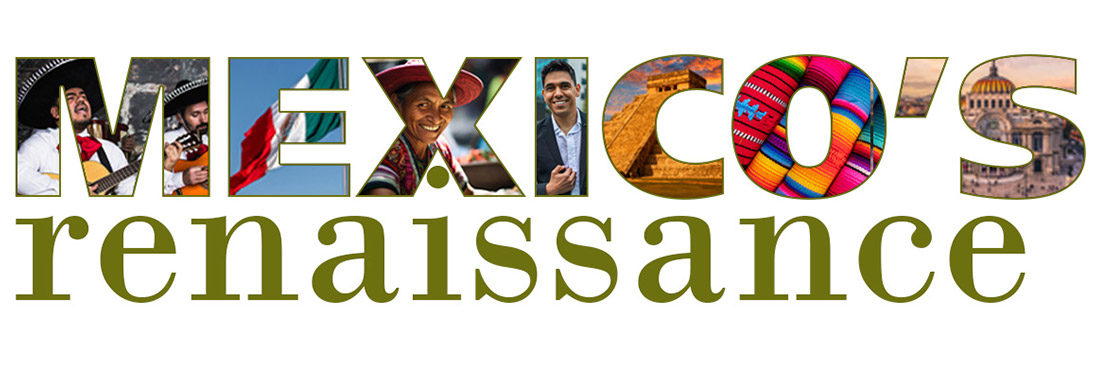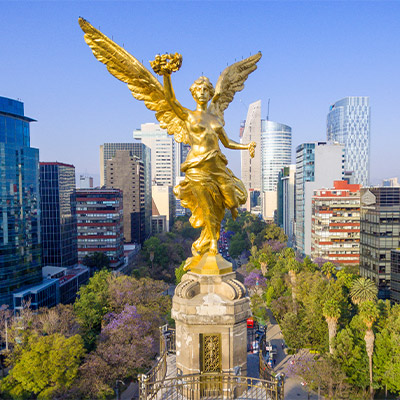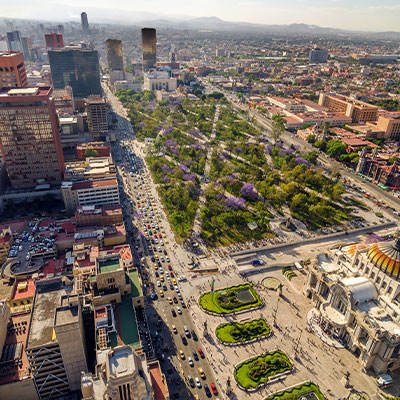Feature: Mexico’s renaissance
Margaret TaylorMonday 18 March 2024

As the IBA prepares to host its annual conference in Mexico, Global Insight reports on the country’s re-emergence as a key destination for companies and the lawyers advising them.
Mexico is back in vogue. Having come of age after signing the tripartite North American Free Trade Agreement (NAFTA) in 1994, the country soon became a popular destination for international companies keen to have easy access to the lucrative North American markets it neighbours. Though Baker McKenzie had taken the pioneering step of opening a Mexico base in 1961, few others followed until White & Case planted its own flag there in 1991. By the 2000s, a slew of firms including Chadbourne & Parke, DLA Piper and Jones Day were all serving clients from their own offices in the country.
Yet while those firms had been attracted by the stabilising effect NAFTA had on the Mexican economy, the rise of China post-millennium posed challenges for the Latin American country, as international businesses looked for cheaper locations for their manufacturing bases. NAFTA had helped set Mexico up as a cost-effective place in which to manufacture or assemble goods destined for its vast northerly neighbours, leading to the so-called maquiladora boom – named after the foreign-owned, locally staffed factories at the centre of the phenomenon. But the terms offered by China in the early 2000s meant it became the go-to destination instead, with Mexico struggling to compete.
Tradewinds pick up
That has all changed since the 2017–21 US presidency of Donald Trump, who, while in office, accused China of everything from unfair trading practices to intellectual property theft, before declaring a trade war with the country in 2018. China took umbrage at what it saw as America’s attempts to curb its rise as an economic power and the two nations between them imposed tariffs on hundreds of billions of dollars’ worth of one another’s goods. Companies that had flocked to China began to head back to Mexico in their droves, with law firms including Cuatrecasas, Dentons, Fisher Phillips and Holland & Knight launching or expanding operations there to service them.

As Jose Larroque, National Managing Partner at Baker McKenzie Mexico, wrote in 2023: ‘Nearshoring opportunities, especially attractive for large, industrial manufacturers, are picking up speed, with several Mexican states racing to generate incentives in key areas such as land access, tax credits, soft landing facilities, and supply-chain support. We can forecast that this trend will continue to provide favourable conditions for investors, with those players making the first move raking in the most benefits’.
Despite their huge differences on domestic issues, Trump’s trade war has been continued under President Joe Biden. Renê Medrado, Co-Chair of the IBA International Trade and Customs Law Committee and a partner at Brazilian firm Pinheiro Neto Advogados, says that, like Trump, Biden views China as too big a threat on the competitive global stage and so has done little to soften his predecessor’s rhetoric. ‘The Trump administration began things with a discussion on national security and used that as a way to raise tariffs and justify trade measures’, he says. ‘The Biden administration has not used national security as much, but [Biden] has spoken about bringing jobs back.’
Either way, while the ongoing trade barriers have provided the impetus for the nearshoring phenomenon, Raj Bhala, Membership Officer of the IBA Academic and Professional Development Committee and Brenneisen Distinguished Professor at the University of Kansas Law School, says a revamp of NAFTA that took effect months after Biden assumed the presidency in 2021 has helped accelerate the nascent Mexican boom. That, he says, is in turn invigorating the legal market there.
‘The North American Free Trade Agreement was renegotiated under the Trump administration as the United States-Mexico-Canada Agreement [USMCA] – we call it NAFTA 2.0’, says Bhala. ‘That creates duty-free and quota-free treatment for all goods across the North American continent. That’s a market of over 400 million people. It also liberates trade in services and it liberates FDI [foreign direct investment]. It’s designed to create a seamless internal market.’
He explains that, in order to take advantage of the tariff-free, quota-free treatment, and to meet the technical or sanitary standards required – or the rules on origin to ensure that goods are made in Canada, Mexico or the US, and not Brazil or India – businesses need lawyers. ‘Sometimes they need a lot of help to understand what the rules are and to qualify for the preferential treatment’, says Bhala.
The nearshoring phenomenon
Horacio López-Portillo, Diversity and Inclusion Officer on the IBA International Commerce and Distribution Committee and name partner at Mexico City firm López Portillo Consultores, agrees that Mexico’s legal market is experiencing a second wave of interest from international players, but says that in addition to the US-China trade war and the impact of USMCA, the boom is also being driven by the fallout from the Covid-19 pandemic.
‘To look at this you have to divide history in two’, he says. ‘The first wave of American firms that were interested in Mexico came towards the end of the maquiladora boom, which coincided with the mid-point of NAFTA in the early 2000s. With the decline of the maquiladora industry these American firms didn’t pull out but they took a step aside and didn’t pursue their interests as much as they could or should have.’
The main driver of the nearshoring phenomenon was the Covid-19 pandemic. Due to its disruption, US companies needed their supply chains to be closer to home
Horacio López-Portillo
Diversity and Inclusion Officer, IBA International Commerce and Distribution Committee
The Mexican business economy as a whole matured as a result of the neo-liberal economic policies in place from 1998 to 2019, but López-Portillo explains that two things happened to energise the industry as a whole and the legal sector, in particular in the last three to four years. ‘The first is the trade war that Trump began against China’, he says. ‘That meant China ceased to be so attractive and so business started to be nearshored to Mexico again. That was very gradual, but the main driver of the nearshoring phenomenon was the Covid-19 pandemic. Due to [its] disruption […] US companies needed their supply chains to be closer to home.’
Analysis from the Federal Reserve Bank of New York’s Liberty Street Economics found that, in the early days of the pandemic, there was a significant decline in the level of goods being exported from China to the US as factories were forced to close and international shipping became heavily disrupted.
‘Imports from China declined sharply in the first quarter [of 2020] while US imports overall decreased to a lesser extent’, economist Sebastian Heise wrote at the time. ‘While imports from China were on average at or below their level one year prior even before the Covid-19 outbreak – due to higher US tariffs and increased trade uncertainty – imports dropped sharply in February and March. This drop is consistent with the widespread quarantine measures in China starting in late January. At the [lowest point], daily imports from China were around 50 per cent lower in 2020 than one year earlier, before bouncing back toward the end of March as quarantine measures were lifted. Total US imports were about 10 per cent below their level one year earlier over this period.’
For Pieter Tubbergen, Senior Vice-Chair of the IBA International Commerce and Distribution Committee and of counsel at Tremont Legal in Rotterdam, the disruption highlighted some of the other impracticalities involved in having supply chains spread over such a vast geographical – and geopolitical – expanse. ‘America is an important destination of global supply chains’, he says. ‘If you have to get your goods there from China then, apart from local conditions, there are quite a lot of geopolitical problems in the way – you have to get them through the Suez Canal, there is piracy on the ocean.’ Tubbergen adds that, even when factories did reopen during the pandemic, it still took a significant amount of time for goods to make their way across the water. ‘With a country like Mexico, which has relatively cheap labour, the goods could be in the US days after a factory reopened’, he says.
Mexico had already paid its dues through all those years of NAFTA and USMCA and that meant it had better infrastructure, well-trained people and a cost structure that’s relatively low
Daniel Del Rio
Member, IBA Latin American Regional Forum Advisory Board
Daniel Del Rio, a Member of the IBA Latin American Regional Forum Advisory Board and a partner at Mexican firm SMPS Legal, agrees. Noting that the pandemic made the cost of shipping goods from China to the US more expensive, he says that, proximity aside, there were a number of elements that combined to make Mexico the obvious alternative choice. ‘The pandemic came, suddenly there were delays in shipping products and the cost of transportation increased too much’, he says. ‘At the end of the day, you need to be able to get goods from the final production line within 24 to 48 hours. That’s what made Mexico attractive. It had already paid its dues through all those years of NAFTA and USMCA and that meant it had better infrastructure, well-trained people and a cost structure that’s relatively low. Salaries have increased under USMCA but they’re still very much competitive.’
‘Population bonus’
Labour is a key element when it comes to determining where international businesses establish their operations. Indeed, during the maquiladora boom, labour was the key ingredient that Mexico brought to the table – the bulk of the companies that set up factories in the country imported their raw materials, with local people being the value-added part of the chain. Population-wise, Mexico is considerably smaller than China, with 129 million inhabitants versus 1.4 billion, but Fernando Erana, Chair of the IBA North American Regional Forum and a partner at Mexican firm Pérez Correa González, says that the labour market there is still huge. At a time when China has become increasingly less attractive, this, coupled with its close ties to the US and Canada, is making Mexico a particularly attractive proposition.
‘Mexico is a large country, that’s the first thing you have to consider’, says Erana. ‘There are 130 million inhabitants, it’s almost two million square kilometres, it’s one of the most-populated countries in the world and is one of the largest countries in the world by land mass. If you put Mexico on top of the map of Europe, you would have Tijuana somewhere around Galway in Ireland and Yucatan somewhere around Istanbul. It’s a very diverse country population-wise and it’s very young – the median age is around 30 to 40, which is younger than Europe. It’s a population bonus.’
While Erana stresses there are still many inequalities to be addressed in Mexico, Tubbergen highlights that the country has advanced enough in recent years for it to be a much safer bet for corporations that want a degree of certainty over the environmental, social and governance (ESG) credentials of their supply chains. ‘You have to choose supply chains on their [ESG] aspects and that’s more difficult when you are further away’, he says. ‘If you take China as an example, it is difficult, depending on which region the factory is in, to know that no forced labour has been involved or if working conditions are acceptable. That’s relatively easier with a county like Mexico.’
As any market starts to mature, disputes will start to arise and that, says Bhala, means law firms operating in Mexico are expanding the type of services they offer their clients there. As well as the usual disputes around labour laws – USMCA, for example, requires that between 40 and 45 per cent of the work done in car manufacturing in Mexico must be paid at a rate of $16 an hour, something that’s enforceable under the terms of the agreement – there’s the potential for illegal trading. While ‘friendshoring’ – defined by the World Economic Forum as ‘the rerouting of supply chains to countries perceived as politically and economically safe or low-risk’ – allows for products to be manufactured in jurisdictions that are deemed allies under USMCA then brought into the US market via Mexico, Bhala says the concept can be abused to try to circumvent the rules.

‘Some manufacturers will try to disguise the true Chinese origins of their products by shipping them through Mexico and falsely claiming they were made in Mexico’, he says. ‘Maybe there will be some minor changes made to the product there and they will seek the duty-free treatment. That circumvents Chinese tariffs and you need lawyers on the ground in Mexico who are paying attention to the movements of shipments.’ He adds that ‘this is all normal and healthy. It’s a good thing in the evolution of the agreement’.
A soft power destination
Mexico is proving popular not only as a cost-effective place to do business, but as a major tourist destination. At the beginning of 2024, Time Out magazine placed Mexico City sixth in a list of the top ten most ‘liveable’ cities in the world, and in 2023 praised it for its culture. López-Portillo says the place has changed hugely in recent years, with Mexico City now ‘like LA or Madrid but without the order – it’s a little more chaotic’. He adds that, ‘due to the Covid pandemic, with the mobility that developed from that and the possibility to work remotely, lawyers from afar have found that they can work practically anywhere, and the weather is nice here’.
Mexico is a very diverse country population-wise and it’s very young – the median age is around 30 to 40, which is younger than Europe. It’s a population bonus
Fernando Erana
Chair, IBA North American Regional Forum
Erana agrees and notes the importance of the ‘cultural soft power’ relationship that has blossomed between the US and Mexico in the years since the pandemic. ‘The largest Mexican expat community is in the US and the largest US expat community is in Mexico’, he says. ‘The economic and cultural integration is deep and that has catapulted Mexico to fame – it has a lot of soft power.’
The movement of expats to Mexico was happening before Covid-19, says Erana, but recently the phenomenon has exploded, and they can now be found in locations such as the Riviera Maya and Guadalajara, and not just in Mexico City. ‘The reason for a lot of that is the cost of living. Mexico City is not that cheap, but it is cheaper than New York or Boston and it’s a cosmopolitan city that has a lot of things going on’, he explains.
Mexico City is the oldest capital on the continent, at 700 years old. It boasts architecture that represents centuries of culture, as well as many museums. As a city, ‘it’s very diverse, very open’, says Erana. ‘Mexico in general is famous for being a conservative country, which is true, but Mexico City is very liberal. Plus, it has a great food scene – you’ll eat just as well at the taco stand on the corner of the street as you will in a Michelin restaurant.’
Later in 2024, both Mexico and the US will elect their next presidents. North of the border, the contest is likely to be between Joe Biden and Donald Trump – both are known quantities and it’s doubtful that either will want to renegotiate the terms of the USMCA. South of the border, Mexicans will almost certainly elect a woman – a first for North America – with Claudia Sheinbaum, the mayor of Mexico City from 2018–23, facing former senator Xóchitl Gálvez.
Whatever the outcome of these elections, Bhala says that relations between the two nations are strong and should remain so. ‘In the 1800s, when the US, Mexico and Texas were fighting violent wars, it was a very […] confrontational relationship’, he says. ‘If you look at US-Mexican relations historically, it’s a very healthy environment right now.’
Margaret Taylor is a freelance journalist and can be contacted at mags.taylor@icloud.com
